List of spaceflight records
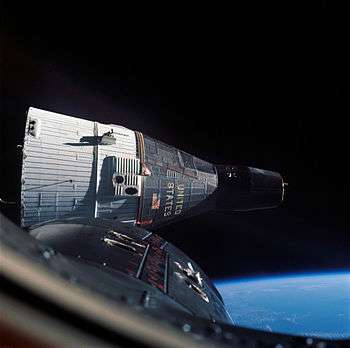
This is a list of spaceflight records. Most of these records relate to human spaceflights, but some unmanned and animal records are listed as well.
First independent suborbital and orbital human spaceflight by country
| Country | Mission | Crew | Spacecraft | Launch vehicle | Date | Type |
|---|---|---|---|---|---|---|
| Vostok 1[1] | Yuri Gagarin[1] | Vostok 3KA[1] | Vostok-K[1] | 12 April 1961[1] | Orbital[1] | |
| Mercury-Redstone 3 (Freedom 7)[2] | Alan Shepard[2] | Mercury Spacecraft No.7[2] | Mercury-Redstone[2] | 5 May 1961[2] | Sub-orbital[2] | |
| Mercury-Atlas 6 (Friendship 7)[3] | John Glenn[3] | Mercury Spacecraft No.13[3] | Atlas LV-3B | 20 February 1962[3] | Orbital[3] | |
| Shenzhou 5[4] | Yang Liwei[4] | Shenzhou spacecraft[4] | Long March 2F[4] | 15 October 2003[4] | Orbital[4] |
Human spaceflight firsts
| First | Person(s) | Mission | Country | Date |
|---|---|---|---|---|
 |
Yuri Gagarin | Vostok 1[5] | 12 April 1961 | |
|
Alan Shepard | Freedom 7 | 5 May 1961 | |
|
Gherman Titov | Vostok 2 | 6 August 1961 – 7 August 1961 | |
| Person to land in a spacecraft after orbital flight | John Glenn | Friendship 7 | 20 February 1962 | |
|
12 August 1962 – 15 August 1962 | |||
|
Valentina Tereshkova | Vostok 6 | 16 June 1963 – 19 June 1963 | |
| Spaceflight (suborbital) by winged spacecraft | Joe Walker | X-15 Flight 90 | 19 July 1963 | |
| Person to enter space twice (suborbital flights above 100 kilometres (62 mi)) | Joe Walker | X-15 Flights 90 and 91 | 22 August 1963 | |
|
Voskhod 1[5] | 12 October 1964 – 13 October 1964 | ||
Spacewalk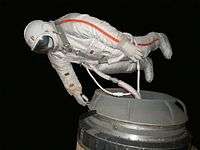 |
Alexey Leonov | Voskhod 2[5] | 18 March 1965 | |
| Orbital maneuvers (change orbit) | Gus Grissom, John W. Young | Gemini 3[5] | 23 March 1965 | |
| Person to fly two orbital spaceflights | Gordon Cooper |
| ||
| Persons to spend one week in space | Gemini 5 | 21 August 1965 – 29 August 1965 | ||
|
15 December 1965 – 16 December 1965 | |||
Space docking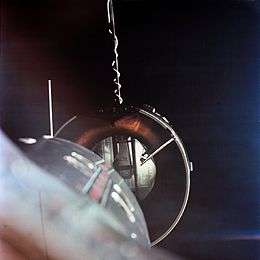 |
Gemini 8 and Agena[5] | 16 March 1966 | ||
| Multiple rendezvous | Gemini 10 with Agena 10 and Agena 8 |
| ||
| Spaceflight fatality (during landing) | Vladimir Komarov | Soyuz 1 | 23 April 1967 – 24 April 1967 | |
| Person to complete three spaceflights | Walter Schirra | 22 October 1968 | ||
 |
Apollo 8 | 24 December 1968 – 25 December 1968 | ||
|
16 January 1969 | |||
| Solo flight around the Moon | John Young | Apollo 10 | 22 May 1969 | |
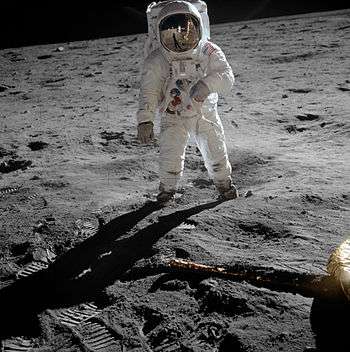 |
Apollo 11 | 20 July 1969 | ||
| Five people in space at the same time | 12 October 1969 – 13 October 1969 | |||
|
13 October 1969 – 16 October 1969 | |||
| Person to complete four spaceflights | James A. Lovell | 17 April 1970 | ||
|
James A. Lovell | 11 April 1970 – 17 April 1970 | ||
|
Soyuz 9 | 1 June 1970 – 19 June 1970 | ||
| People to EVA out of sight of their spacecraft | Apollo 14 | 6 February 1971 | ||
|
22 April 1971 – 24 April 1971 | |||
Manned space station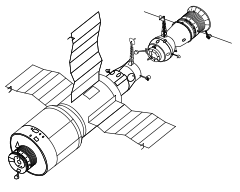 |
7 June 1971 – 29 June 1971 | |||
| In-space fatalities | Soyuz 11 | 29 June 1971 | ||
People to travel in a wheeled vehicle on a planetary body other than Earth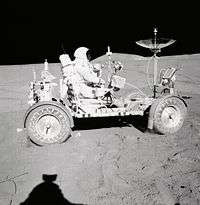 |
Apollo 15 | 31 July 1971– 2 August 1971 | ||
| EVA outside low Earth orbit (trans-Earth trajectory) | Al Worden | Apollo 15 | 5 August 1971 | |
| Person to be in lunar orbit twice (during separate lunar expeditions) | John W. Young | 16 April 1972 – 27 April 1972 | ||
| People in orbit for four weeks | Skylab 2 | 25 May 1973 – 22 June 1973 | ||
| People in orbit for eight weeks | Skylab 3 | 28 July 1973 – 25 September 1973 | ||
| People in orbit for 12 weeks | Skylab 4 | 16 November 1973 – 8 February 1974 | ||
|
Vasily Lazarev, Oleg Makarov | Soyuz 18a | 5 April 1975 | |
| Crew to visit occupied space station | Vladimir Dzhanibekov, Oleg Makarov | Soyuz 27 visits Salyut 6 EO-1 crew | 10 January 1978 – 16 January 1978 | |
| People in orbit 19 weeks (4 months) |
Vladimir Kovalyonok, Aleksandr Ivanchenkov | Salyut 6 EO-2, Soyuz 29-Soyuz 31 | 15 June 1978 – 2 November 1978 | |
| People in orbit 26 weeks (6 months) |
Leonid Popov, Valery Ryumin | Salyut 6 EO-4, Soyuz 35-Soyuz 37 | 9 April 1980 – 11 October 1980 | |
| Spaceflight (orbital) by winged spacecraft | STS-1 | 12 April 1981 | ||
| Person to fly four different types of spacecraft | John W. Young |
|
12 April 1981 | |
| Person to complete five spaceflights | John W. Young | 14 April 1981 | ||
| Four-person spaceflight in a single spacecraft | STS-5 | 11 November 1982 – 16 November 1982 | ||
| Five-person spaceflight in a single spacecraft | STS-7 | 18 June 1983 – 24 June 1983 | ||
| Six-person spaceflight in a single spacecraft | STS-9 | 28 November 1983 – 8 December 1983 | ||
| Person to complete six spaceflights | John W. Young | 8 December 1983 | ||
Untethered spacewalk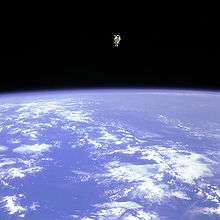 |
Bruce McCandless II | STS-41-B | 7 February 1984 | |
| Eight people in space at the same time (no docking) | Salyut 7 EO-3, Soyuz T-10, STS-41-B | 8 February 1984 – 11 February 1984 | ||
| 11 people in space at the same time (no docking) | STS-41-C, Salyut 7 EO-3, Soyuz T-10-Soyuz T-11 | 6 April 1984 – 11 April 1984 | ||
| People to complete four spacewalks during the same mission | Leonid Kizim, Vladimir Solovyov | Salyut 7 | 26 April – 18 May 1984 | |
| Spacewalk by a woman | Svetlana Savitskaya | Soyuz T-12 | 25 July 1984 | |
| People in orbit 33 weeks (7 months) | Leonid Kizim, Vladimir Solovyov, Oleg Atkov | Salyut 7 EO-3, Soyuz T-10-Soyuz T-11 | 8 February 1984 – 2 October 1984 | |
Seven-person spaceflight in a single spacecraft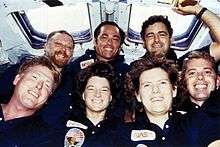 |
STS-41-G | 5 October 1984 – 13 October 1984 | ||
| Two women in space at the same time | Kathryn D. Sullivan, Sally K. Ride | STS-41-G | 5 October 1984 – 13 October 1984 | |
| Partial crew exchange at a space station | Alexander Volkov, Vladimir Vasyutin replace Vladimir Dzhanibekov | Soyuz T-14, Salyut 7 | 17 September 1985 – 26 September 1985 | |
Eight-person spaceflight in a single spacecraft |
|
STS-61-A | 30 October 1985 – 6 November 1985 | |
| Fatalities during launch | STS-51-L | 28 January 1986 | ||
|
Soyuz T-15 from Mir to Salyut 7 back to Mir[6] | 15 March 1986 – 16 July 1986 | ||
| Complete crew exchange at a space station | Vladimir Titov, Musa Manarov replace Yuri Romanenko, Alexander Alexandrov | Soyuz TM-4-Soyuz TM-2, Soyuz TM-3, at Mir | 21 December 1987 – 29 December 1987 | |
| People in orbit 52 weeks (one year) | Vladimir Titov, Musa Manarov | Mir EO-3, Soyuz TM-4-Soyuz TM-6 | 21 December 1987 – 21 December 1988 | |
| 12 people in space at the same time (no docking) |
|
STS-35, Mir EO-7, Soyuz TM-10-Soyuz TM-11 | 2 December 1990 – 10 December 1990 | |
| Three women in space at the same time | Millie Hughes-Fulford, Tamara E. Jernigan, M. Rhea Seddon | STS-40 | 5 June 1991 – 14 June 1991 | |
Three-person spacewalk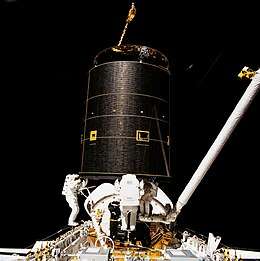 |
STS-49 | 13 May 1992 | ||
| 13 people in space at the same time (no docking) |
|
STS-67, Mir, Soyuz TM-20, Soyuz TM-21 | 14 March 1995 – 18 March 1995 | |
Ten people in a single spacecraft (docking)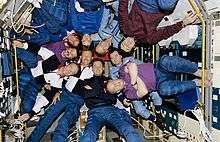 |
STS-71, Mir, Soyuz TM-21 | 29 June 1995 – 4 July 1995 | ||
| Space tourist | Dennis Tito | Soyuz TM-32/31, ISS EP-1 | April 28, 2001 – May 6, 2001 | |
| Person to complete seven trips to space | Jerry L. Ross | 19 April 2002 | ||
Privately funded human space flight (suborbital)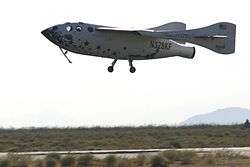 |
Mike Melvill | SpaceShipOne flight 15P | 21 June 2004 | |
13 people in a single spacecraft (docking)[7]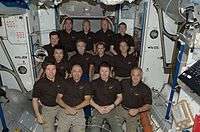 |
|
ISS, Soyuz TMA-14, Soyuz TMA-15, STS-127 | 17 July 2009 | |
Four women in space at the same time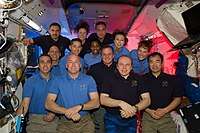 |
|
5 April 2010 – 20 April 2010 | ||
| Six spacecraft docked to a space station |
|
9 July 2018 |
Most spaceflights
- 7 spaceflights
- Jerry L. Ross – USA[7]
- Franklin Chang Díaz – Costa Rica/USA*[7]
- 6 spaceflights
- John W. Young[8] – USA (While Young has made six spaceflights, he was launched into orbit seven times if his moon ascent on Apollo 16 is counted.)
- Story Musgrave – USA
- Curtis Brown – USA
- James Wetherbee – USA
- Michael Foale – United Kingdom/USA dual citizen
- Sergei Krikalev – Russia[9]
- Yuri Malenchenko – Russia
Duration records
Total human spaceflight time by country
| Nation | Total persons | Total person flights | Total in orbit (@ update)* | Total person days*+ | % of Total person days |
|---|---|---|---|---|---|
| TOTAL | 555 | 1256 | 3 | 52845.90 | - |
| 123 | 269 | 1 | 27538.82 | ||
| 340 | 851 | 1 | 20192.50 | ||
| 39 | 64 | 1 | 2907.46 | ||
| 12 | 20 | - | 1354.76 | ||
| 11 | 16 | 1 | 794.67 | ||
| 7 | 12 | - | 765.92 | ||
| 10 | 18 | - | 628.92 | ||
| 9 | 17 | - | 506.14 | ||
| 2 | 3 | - | 210.69 | ||
| 2 | 3 | - | 207.65 | ||
| 2 | 2 | - | 193.81 | ||
| 11 | 14 | - | 165.35 | ||
| 1 | 4 | - | 42.50 | ||
| 1 | 2 | - | 26.73 | ||
| 1 | 2 | - | 18.78 | ||
| 1 | 1 | - | 15.93 | ||
| 1 | 1 | - | 15.69 | ||
| 2 | 2 | - | 11.80 | ||
| 1 | 1 | - | 10.88 | ||
| 1 | 1 | - | 10.88 | ||
| 1 | 1 | - | 9.89 | ||
| 1 | 1 | - | 9.89 | ||
| 1 | 1 | - | 9.84 | ||
| 1 | 1 | - | 9.84 | ||
| 1 | 1 | - | 8.85 | ||
| 1 | 1 | - | 7.96 | ||
| 1 | 1 | - | 7.93 | ||
| 1 | 1 | - | 7.93 | ||
| 1 | 1 | - | 7.92 | ||
| 1 | 1 | - | 7.91 | ||
| 1 | 1 | - | 7.90 | ||
| 1 | 1 | - | 7.86 | ||
| 1 | 1 | - | 7.86 | ||
| 1 | 1 | - | 7.86 | ||
| 1 | 1 | - | 7.86 | ||
| 1 | 1 | - | 7.86 | ||
| 1 | 1 | - | 7.07 | ||
| 1 | 1 | - | 6.88 | ||
| Astronauts currently in space: |
Crew Vehicles currently in space: Soyuz MS-09 | ||||
| Table data accurate as of 2018-10-20 04:05 UTC | |||||
| * includes those in orbit at time table was updated +TOTAL person days in orbit will not match the sum of the totals for individual nations as some individuals are dual citizens (based solely on those identified as such by spacefacts.de - see table references). | |||||
Most time in space
Russian cosmonaut Gennady Padalka, who has spent 878 days in space over five missions, became the record holder for the most time spent in space when he surpassed, on 28 June 2015, the record of cosmonaut Sergei Krikalev, who spent 803 days, 9 hours and 39 minutes (about 2.2 years) in space over the span of six spaceflights on Soyuz, the Space Shuttle, Mir, and the International Space Station. Yuri Malenchenko is currently in second place, having spent 828 days in space on six spaceflights.[9][12][13][14]
The following is a list of the 50 space travelers with the most total time in space, as of 5 October 2018.[15] Travelers currently in space are ranked by total time in space of their completed missions only.
Color key:
- Currently in space
- Active
- Retired
- Deceased
Ten longest human spaceflights
Longest single flight by a woman
NASA astronaut Peggy Whitson holds the record for the longest single spaceflight by a woman when she surpassed Italian astronaut Samantha Cristoforetti's 199 days, 16 hours during Expedition 52 in 2017. She returned to Earth in September 2017, having spent 289 days, 5 hours and 1 minute in space.[25][26] In third place is American astronaut Sunita Williams with 195 days[27][28] on the ISS, where she was a member of Expedition 14/Expedition 15 (2006–2007).
Longest continuous occupation of space
An international partnership consisting of Russia, the United States, Canada, Japan and the member states of the European Space Agency have jointly maintained a continuous human presence in space since 31 October 2000, when Soyuz TM-31 was launched. Two days later it docked with the International Space Station.[7][29] Since then space has been continuously occupied for 17 years, 354 days.[7]
Longest continuous occupation of a spacecraft
The International Space Station has been continuously occupied since 2 November 2000 (17 years, 352 days).[7][29] It broke the record of 9 years and 358 days of the Soviet/Russian Space Station Mir on 23 October 2010.[29]
Longest solo flight
Valery Bykovsky flew solo for 4 days, 23 hours in Vostok 5 from 14 to 19 June 1963.[30] The flight set a space endurance record which was broken in 1965 by the (non-solo) Gemini 5 flight. The Apollo program included long solo spaceflight, and during the Apollo 16 mission, T.K. Mattingly orbited solo around the Moon for more than 3 days and 9 hours.
Longest time on the lunar surface
Eugene Cernan and Harrison Schmitt of the Apollo 17 mission stayed for 74 hours 59 minutes and 40 seconds (over 3 days) on the lunar surface after they landed on 11 December 1972.[31] They performed three EVAs (extra-vehicular activity) totaling 22 hours 3 minutes, 57 seconds (as commanders were always the first one out of the LM and the last to get back in, Cernan's EVA time was slightly longer).[31]
Longest time in lunar orbit
Ronald Evans of Apollo 17 mission stayed in lunar orbit for 6 days and 4 hours (148 hours);[32] however, for the solo portion of that flight around the Moon, T. K. Mattingly on Apollo 16 spent 1 hour 38 minutes longer than Evans' solo duration.
Speed and altitude records
Farthest humans from Earth
The Apollo 13 crew (Jim Lovell, Fred Haise, and Jack Swigert), while passing over the far side of the moon at an altitude of 254 km (158 mi) from the lunar surface, were 400,171 km (248,655 mi) from Earth.[33] This record-breaking distance was reached at 0:21 UTC on 15 April 1970.[33]
Highest altitude for manned non-lunar mission
Gemini 11 crew Charles Conrad, Jr. and Richard F. Gordon, Jr. fired their Agena Target Vehicle rocket engine on 14 September 1966, at 40 hours 30 minutes after liftoff and achieved a record apogee altitude of 739.2 nautical miles (1,369.0 km).[34]
Fastest
The Apollo 10 crew (Thomas Stafford, John W. Young and Eugene Cernan) achieved the highest speed relative to Earth ever attained by humans: 39,897 kilometers per hour (11.082 kilometers per second or 24,791 miles per hour, approximately 32 times the speed of sound and 0.0037 percent of the speed of light).[7] The record was set 26 May 1969.[7]
Age records

Earliest-born to reach space (suborbital flight)
Joe Walker (born 20 February 1921), on X-15 Flight 90 on 19 July 1963.
Earliest-born to reach space (orbital flight)
- Man – Georgy Beregovoy (born 15 April 1921), on Soyuz 3 on 26 October 1968.
- Woman – Valentina Tereshkova (born 6 March 1937), on Vostok 6 on 16–19 June 1963.
Youngest (age during spaceflight)
- Man – Gherman Titov (aged 25 years), on Vostok 2 on 6 August 1961.[7]
- Woman – Valentina Tereshkova (aged 26 years), on Vostok 6 on 16–19 June 1963.
Oldest (age during spaceflight)
- Man – John Glenn (aged 77), on STS-95 on 29 October 1998.[7]
- Woman – Peggy Whitson (aged 56), on Soyuz MS-03 on 17 November 2016. She turned 57 on 9 February 2017, while still in space.[35]
Spacewalk records
Most spacewalks
- Man – Anatoly Solovyev, 16 spacewalks for a total time of 82 hours, 21 minutes (which is also the duration record).[36]
- Woman – Peggy Whitson, 10 spacewalks for a total time of 60 hours, 21 minutes.[37][38][39]
Most spacewalks during a single mission
- 7: Anatoly Solovyev, during the 24th Expedition on the Soviet/Russian space station Mir, in 1997–98. (Two were internal "spacewalks" inside a depressurized module.)
- 6: Leonid Kizim and Vladimir Solovyov, the third crew on the Soviet space station Salyut 7.
Animal records
First living organisms in space
The first living organisms of any kind to enter space were fruit flies launched by the United States in 1947 aboard a V-2 rocket to an altitude of 68 miles (109 km).[40] They were also the first animals to safely return from space.[40]
First animal in orbit
Laika was a Soviet female canine launched on 3 November 1957 on Sputnik 2. The technology to de-orbit had not yet been developed, so there was no expectation for survival. She died several hours into flight. Belka and Strelka became the first canines to safely return to Earth from orbit on 19 August 1960.
Longest canine single flight
Soviet space dogs Veterok (Ветерок, "Light Wind") and Ugolyok (Уголёк, "Ember") were launched on 22 February 1966 on board Cosmos 110 and spent 22 days in orbit before landing on 16 March.
First animals beyond low-Earth orbit
An assortment of animals including a pair of Russian tortoises, as well as wine flies and mealworms launched with a number of other biological specimens including seeds and bacteria on a circumlunar mission aboard the Soviet Zond 5 spacecraft on 15 September 1968.[40] It was launched by a Proton-K rocket.[40] The capsule came within 2,000 kilometres (1,200 mi) of the Moon and later successfully returned to Earth, the first spacecraft in history to return safely to Earth from the Moon.[40]
Notable unmanned spaceflights
| In reference to: | Spacecraft | Event | Origin | Date |
|---|---|---|---|---|
| Earth | MW 18014 (A-4(V-2)) | First rocket to reach space (suborbital flight). | 20 June 1944 | |
| Earth | V-2 No. 20 | First living organisms (fruit flies) in space (suborbital flight). Successfully recovered. | 20 February 1947 | |
| Earth | R-1V[41] | First mammals (dogs) in space (suborbital flight). Successfully recovered. | 22 July 1951 | |
| Earth | Sputnik 1 | First satellite in orbit.[5] | 4 October 1957 | |
| Earth | Sputnik 2 | First animal in orbit, Laika the dog. | 3 November 1957 | |
| Earth | Vanguard 1 | Oldest satellite still in orbit, in addition to its upper launch stage. Expected to stay in orbit 240 years. Ceased transmission in May 1964. | 17 March 1958 | |
| Earth | Pioneer 1 | Failed to reach the moon as intended, but reached a record–setting distance of 113,800 kilometres (70,700 mi) from Earth. | 11 October 1958 | |
| Earth | Jupiter AM-13 | First monkey in space, Gordo, a squirrel monkey. | 13 December 1958 | |
| Earth | Luna 1 | First spacecraft to achieve Earth's escape velocity. | 4 January 1959 | |
| Moon | Luna 1 | First flyby. Distance of 5,995 kilometres (3,725 mi). | 4 January 1959 | |
| Sun | Luna 1 | First spacecraft in heliocentric orbit. | 4 January 1959 | |
| Moon | Luna 2 | First impact.[5] | 14 September 1959 | |
| Moon | Luna 3 | First image of lunar far-side.[5] | 7 October 1959 | |
| Earth | Discoverer 13 | First satellite recovered from orbit.[5] | 11 August 1960 | |
| Earth | Korabl-Sputnik 2 | First living beings recovered from orbit.[42] | 19 August 1960 | |
| Venus | Venera 1 | First flyby. Distance of 100,000 kilometres (62,000 mi) (lost communication contact before).[5] | 19 May 1961 | |
| Moon | Ranger 4 | First spacecraft to impact the far side of the Moon.[43] | 26 April 1962 | |
| Earth | Alouette 1 | First satellite designed and constructed by a country other than the USA or USSR (the British satellite Ariel 1, launched five months earlier, was designed and constructed by the USA).[44] | 29 September 1962 | |
| Venus | Mariner 2 | First planetary flyby. Distance of 34,762 kilometres (21,600 mi) (with communication contact). | 14 December 1962 | |
| Earth | Lincoln Calibration Sphere 1 | Oldest spacecraft still in use (50 years as of 2015). | 6 May 1965 | |
| Mars | Mariner 4 | First flyby and first planetary imaging. Distance of 9,846 kilometres (6,118 mi). | 14 July 1965 | |
| Earth | Astérix | First satellite launched independently by a nation other than the USA or USSR (other nations had previously flown satellites launched on American rockets). | 26 November 1965 | |
| Moon | Luna 9 | First soft landing and first pictures from the lunar surface.[5] | 3 February 1966 | |
| Venus | Venera 3 | First impact.[5] | 1 March 1966 | |
| Moon | Luna 10 | First orbiter.[5] | 3 April 1966 | |
| Docking | Cosmos 186, Cosmos 188 | First automated docking of unmanned spacecraft. | 30 October 1967 | |
| Moon | Zond 5 |
|
15 September 1968 | |
| Moon | Luna 16 | First automated sample return. | 24 September 1970 | |
| Moon | Luna 17 | First automated roving vehicle, Lunokhod 1. | 17 November 1970 | |
| Venus | Venera 7 | First soft landing. | 15 December 1970 | |
| Mars | Mariner 9 | First orbiter. | 14 November 1971 | |
| Mars | Mars 2 | First impact. | 27 November 1971 | |
| Mars | Mars 3 | First soft landing. Maintained telemetry signal for 20 seconds before transmissions ceased. | 2 December 1971 | |
| Sun | Pioneer 10 | First spacecraft to achieve the Sun's escape velocity. | 3 March 1972 | |
| Jupiter | Pioneer 10 | First flyby. Distance of 132,000 kilometres (82,000 mi). | 4 December 1973 | |
| Mercury | Mariner 10 | First flyby. Distance of 703 kilometres (437 mi). | 29 March 1974 | |
| Venus | Venera 9 |
|
22 October 1975 | |
| Sun | Helios 2 |
|
|
17 April 1976 |
| Mars | Viking 1 | First surface-level imaging of Mars. | 20 July 1976 | |
| Saturn | Pioneer 11 | First flyby. Distance of 21,000 kilometres (13,000 mi). | 1 September 1979 | |
| Venus | Venera 13 | First sound recording made on another planet. | 1 March 1982 | |
| Trans-Neptunian region | Pioneer 10 | First to travel past the orbit of Neptune, the furthest major planet from the Sun. | 13 June 1983 | |
| Venus | Vega 1 | First helium balloon atmospheric probe. | 11 June 1985 | |
| Comet Giacobini-Zinner | International Cometary Explorer (ICE) | First flyby through a comet tail (no pictures). Distance of 7,800 kilometres (4,800 mi). | 11 September 1985 | |
| Uranus | Voyager 2 | First flyby. Distance of 81,500 kilometres (50,600 mi). | 24 January 1986 | |
| Comet Halley | Vega 1 | First comet flyby (with pictures returned). Distance of 8,890 kilometres (5,520 mi). | 6 March 1986 | |
| Orbital Spaceplane | Buran | First fully automated orbital flight of a spaceplane (with airstrip landing). | 15 November 1988 | |
| Phobos | Phobos 2 | First flyby. Distance of 860 kilometres (530 mi). | 21 February 1989 | |
| Neptune | Voyager 2 | First flyby. Distance of 40,000 kilometres (25,000 mi). | 25 August 1989 | |
| 951 Gaspra | Galileo | First asteroid flyby. Distance of 1,600 kilometres (990 mi). | 29 October 1991 | |
| Jupiter | Galileo probe | First impact. | 7 December 1995 | |
| Jupiter | Galileo | First orbiter. | 8 December 1995 | |
| Mars | Mars Pathfinder | First automated roving vehicle, Sojourner. | 4 July 1997 | |
| 433 Eros | NEAR Shoemaker | First asteroid orbiter. | 14 February 2000 | |
| 433 Eros | NEAR Shoemaker | First asteroid soft landing. | 12 February 2001 | |
| Saturn | Cassini orbiter | First orbiter. | 1 July 2004 | |
| Solar wind | Genesis | First sample return from farther than the Moon. | 8 September 2004 | |
| Titan | Huygens probe | First soft landing. | 14 January 2005 | |
| Comet Tempel 1 | Deep Impact | First comet impact. | 4 July 2005 | |
| 25143 Itokawa | Hayabusa |
|
19 November 2005 | |
| 81P/Wild | Stardust | First sample return from comet. | 15 January 2006 | |
| Earth | Voyager 1 |
|
As of November 2016[45] | |
| Longest time in operation | Voyager 2 | Longest continually operating space probe (since August 1977). | As of 2015 | |
| Earth to Venus trajectory | IKAROS | First interplanetary solar sail. | Set sail on 10 June 2010 | |
| 25143 Itokawa | Hayabusa | First sample return from an asteroid. | 13 June 2010 | |
| Mercury | MESSENGER | First orbiter. | 17 March 2011 | |
| Earth–Sun L2 Lagrangian point | Chang'e 2 | First object to reach the L2 Lagrangian point directly from lunar orbit.[46] | 25 August 2011 | |
| International Space Station | SpaceX Dragon | First commercial spacecraft to berth with the International Space Station. | 25 May 2012 | |
| Interstellar medium | Voyager 1 | First spacecraft to cross the heliopause, thereby exiting the heliosphere and entering interstellar space. | 25 August 2012 | |
| 4179 Toutatis | Chang'e 2 |
|
13 December 2012 | |
| 67P/Churyumov–Gerasimenko | Rosetta | First comet orbiter.[48] | 6 August 2014 | |
| 67P/Churyumov–Gerasimenko | Philae | First comet soft landing.[49] | 12 November 2014 | |
| Ceres | Dawn | First dwarf planet orbiter.[50] | 6 March 2015 | |
| Mars | Opportunity | Longest distance traveled on surface of another world (26.219 miles (42.195 km), marathon-length).[51] | 23 March 2015 (ongoing) | |
| Mercury | MESSENGER | First impact.[52] | 30 April 2015 | |
| Pluto | New Horizons | 14 July 2015 | ||
| All 9 planets in the pre-IAU redefinition version of the Solar System | All United States spacecrafts including New Horizons | With the New Horizons flyby of Pluto, the United States is the first nation to have its space probes explore all 9 planets in the pre-2006 IAU redefinition version of the Solar System. | 14 July 2015 | |
| Earth | Juno | Fastest man-made object relative to Earth (c. 265,000 kilometres per hour (165,000 mph)).[53] | 4 July 2016 | |
| Earth | Falcon 9 | First re-flight of orbital class rocket.[54] | 30 March 2017 | |
| Earth | Shortest period between orbital launches (launched 72 seconds apart).[55] | 23 December 2017 |
See also
- List of crewed spacecraft
- List of cumulative spacewalk records
- List of International Space Station spacewalks
- List of Mir spacewalks
- List of spacewalkers
- List of spacewalks 2000–2014
- List of spacewalks and moonwalks 1965–1999
- List of spacewalks since 2015
- Manned Maneuvering Unit
- Omega Speedmaster
- Simplified Aid For EVA Rescue
- Space suit
- Suitport
References
- 1 2 3 4 5 6 7 Gebhardt, Chris (12 April 2011). "Anniversaries: 50 years of human spaceflight – 30 years for Shuttle". NASASpaceFlight (not affiliated with NASA). Retrieved 22 June 2015.
- 1 2 3 4 5 6 7 "Mercury-Redstone 3 (Freedom 7)". NASA. 1 November 2011. Retrieved 22 June 2015.
- 1 2 3 4 5 6 "Mercury-Atlas 6 (Friendship 7)". NASA. 20 November 2006. Retrieved 22 June 2015.
- 1 2 3 4 5 6 7 "Making History: China's First Human Spaceflight". Space.com. 28 September 2005. Retrieved 22 June 2015.
- 1 2 3 4 5 6 7 8 9 10 11 12 13 14 "MAJOR SPACE "FIRSTS'-AN AMERICAN ASSESSMENT" (PDF). Flight. 91 (3028): 459. 1967-03-23. Retrieved 2009-04-15.
- 1 2 3 4 5 6 Pearlman, Robert (17 June 2010). "Cosmonaut Leonid Kizim, Who Visited 2 Space Stations in 1 Mission, Dies". Space.com. Retrieved 13 April 2015.
- 1 2 3 4 5 6 7 8 9 10 Wall, Mike (11 March 2015). "The Most Extreme Human Spaceflight Records". Space.com. Retrieved 26 June 2015.
- ↑ "Astronaut Biography". NASA.
- 1 2 NASA (2005). "Sergei Konstantinovich Krikalev Biography". NASA. Retrieved 2007-10-04.
- ↑ "Astronauts and Cosmonauts flown in space (in alphabetical order)". spacefacts.de. The alphabetical list of astronauts provides the "Total Persons" "Total Person Flights" as well as the "Total person days", excepting the time of astronauts currently in orbit
- ↑ "Manned spaceflights". spacefacts.de. The flight list allows is searched to determine which flight is in orbit, and when it reached orbit. This allows determination of "Total in orbit (@ update) and update the "Total person days" accordingly.
- ↑ NASA (2005). "Krikalev Sets Time-in-Space Record". NASA. Retrieved 2007-10-04.
- ↑ Thompson, Curtiss (29 June 2015). "Russian Cosmonaut Sets Record For Most Time Spent In Space". Penny4NASA. Retrieved 1 July 2015.
- ↑ Russian astronaut record-breaker Padalka returns to Earth, BBC News, 12 September 2015
- ↑ "Astronauts and Cosmonauts (sorted by "Time in Space")". spacefacts.de. The current missions are listed but not included in day count.
- ↑ Northon, Karen (2016-03-11). "Astronaut Scott Kelly to Retire from NASA in April". NASA. Retrieved 2016-06-01.
- ↑ Michael Foale holds dual U.S./British citizenship.
- 1 2 3 Schwirtz, Michael (2009-03-30). "Staying Put on Earth, Taking a Step to Mars". The New York Times. Retrieved 2009-04-15.
- 1 2 3 4 5 6 7 8 Pearlman, Robert (26 March 2015). "One Year in Space: A History of Ultra-Long Missions Off Planet Earth". Space.com. Retrieved 13 April 2015.
- 1 2 3 Carroll, Michael (2015). Living Among Giants: Exploring and Settling the Outer Solar System. Springer. p. 195. ISBN 3319106732.
- 1 2 3 Leary, Warren (4 Feb 1994). "Man in the News: Sergei Konstantinovich Krikalev; Symbol of New Cooperation". Cape Canaveral: New York Times. Retrieved 13 April 2015.
- 1 2 3 "Soyuz MS-04 lands as Peggy Whitson ends record-breaking mission". NASASpaceflight. 2 Sep 2017. Retrieved 4 September 2017.
- 1 2 3 Dunn, Marcia (28 Dec 1997). "Mischief a Specialty for Mir's Doctor in Residence". Associated Press. Retrieved 13 April 2015.
- 1 2 3 4 Wenz, John (27 March 2015). "5 Things You Must Know About Scott Kelly's Year in Space". Popular Mechanics. Retrieved 13 April 2015.
- ↑ {{cite web|url=http://www.spacefacts.de/bios/astronauts/english/whitson_peggy.htm%7Ctitle=Peggy Whitson Astronaut Biography|publisher=Space Facts
- ↑ American Astronaut Peggy Whitson Sets Record for Women in Space, James Rogers, Fox News Channel, Apr 24 2017
- ↑ Tariq Malik (2007). "Orbital Champ: ISS Astronaut Sets New U.S. Spacewalk Record". Space.com.
- ↑ "Astronaut Bio: Sunita Williams (5/2008)". NASA Logo National Aeronautics and Space Administration. Retrieved 2009-05-07.
- 1 2 3 "10 Years and Counting". NASA. 28 October 2010. Retrieved 22 June 2015.
- ↑ "Astronautic World Records: Spacecraft with one astronaut – General category". Fédération Aéronautique Internationale. Archived from the original on 2015-09-24. This only counts the duration of solo flight within a mission, so a longer mission with solo flight, such as Apollo 17 at 12d+13h duration is surpassed because the solo undocked duration was only 3d+7h.)
- 1 2 "Mission Report: Apollo 17 – The Most Productive Lunar Expedition" (PDF). NASA. Retrieved 21 June 2015.
- ↑ "Ronal Evans Biographical Data". NASA. April 1990. Retrieved 21 June 2015.
longest time in lunar orbit, 147 hours, 48 minutes
- 1 2 "Apollo 13 The Seventh Mission: The Third Lunar Landing Attempt 11 April–17 April 1970". NASA. Retrieved 7 November 2015.
- ↑ Dumoulin, Jim (August 25, 2000), NASA Project Gemini-XI, retrieved April 12, 2010
- ↑ News, ABC. "ABC News".
- ↑ "GCTC, Biographies of Cosmonauts: Solovyev, Anatoly Yakovlevich". Gagarin Cosmonaut Training Centre. Archived from the original on 2007-09-20. Retrieved 2017-10-31.
- ↑ Spacewalking astronauts pull off urgent station repairs, May 23, 2017
- ↑ "ISS astronauts complete 200th station EVA for maintenance tasks". NASASpaceflight.com. 12 May 2017. Retrieved 13 May 2017.
- ↑ Spacefacts (2017). "Astronauts and Cosmonauts with EVA Experience (sorted by "EVA Time")". Spacefacts. Retrieved May 13, 2017.
- 1 2 3 4 5 Tate, Karl. "Cosmic Menagerie: A History of Animals in Space (Infographic)" (infographic). Space.com. Retrieved June 28, 2014.
- ↑ "R-1V". Archived from the original on 5 August 2014. Retrieved 30 September 2014.
- ↑ Asif A. Siddiqi. "Challenge to Apollo" (PDF). NASA. ; see page. 253
- ↑ Williamson, Mark (1998). "Protecting the space environment: Are we doing enough?". Space Policy. 14 (1): 5–8. doi:10.1016/S0265-9646(97)00038-6.
- ↑ "Alouette I and II". Canadian Space Agency. Government of Canada. Retrieved 6 December 2017.
- ↑ "Where are the Voyagers?". Retrieved 2016-11-27.
Because Earth moves around the sun faster than Voyager 1 is traveling from Earth, the distance between Earth and the spacecraft actually decreases at certain times of the year.
- ↑ "Ching'e 2 to reaches liberation point 2". 2011-08-27.
- ↑ "China's space probe flies by asteroid Toutatis". Chinadaily.com.cn.16 December 2012.
- ↑ esa. "Rosetta arrives at comet destination".
- ↑ "Philae probe makes historic comet landing". 12 November 2014 – via www.bbc.com.
- ↑ CNN, Amanda Barnett. "NASA's Dawn spacecraft begins orbiting Ceres".
- ↑ CNN, Euan McKirdy. "Opportunity rover celebrates marathon milestone".
- ↑ Corum, Jonathan (30 April 2015). "Messenger's Collision Course With Mercury" – via NYTimes.com.
- ↑ "Fastest-Ever Spacecraft to Arrive at Jupiter Tonight".
- ↑ "Used SpaceX Rocket Launches Satellite, Then Lands in Historic 1st Reflight".
- ↑ "TMRO:Space - Looking forward to 2018 - Orbit 11.01".

.jpg)